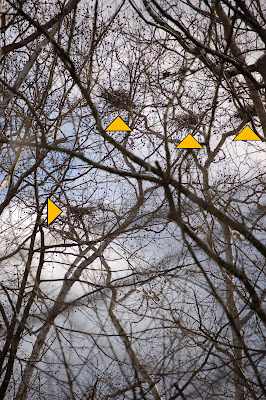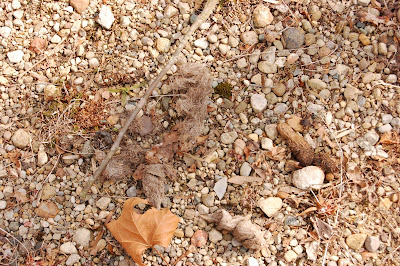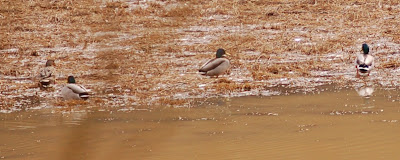Day 3 of the GBBC turned out to be my best day yet! I bested the total number of species for my backyard by 1 (as compared to day 2), recorded my overall highest number of species at another location, and added some completely new species to the mix.
I counted my yard sporadically throughout the day, and spent about 30 minutes in the evening watching the ground feeders go crazy under the feeders at our deck. Here's the yard count.
Count for my backyard (day 3):Northern Cardinal (6)
Pine Siskin (7)
American Goldfinch (10)
Mourning Dove (8)
Chickadee (5)
White-breasted Nuthatch (2)
Red-bellied Woodpecker (2)
Downy Woodpecker (1)
Tufted Titmouse (2)
Song Sparrow (5)
Hairy Woodpecker (1)
Blue Jay (2)
Eastern Towhee (1)
White-throated Sparrow (6)
American Crow (4)
Some notes about my backyard count:
- This is the first time I've seen a Hairy Woodpecker in 3 weeks, which is unusual. Most of the time there is at least 1 Downy and 1 Hairy around when I'm counting. This is definitely the longest lag in between sightings since the FeederWatch season started in November. FINALLY, I got to add a new species to my Great Bird Count of February list!
- First time I've spotted 2 Red-bellied's simultaneously this FeederWatch season. I'm hoping it's a nesting pair. I love seeing Red-bellied babies in the summer!
- The Pine Siskins continue to hang in there! This irruption year for the Siskins has been all the buzz in the birding community, and there's a blurb about the "invasion" over on the GBBC site, along with a very cool animated map that tracks the Siskin's presence in the lower 48 states from 2000-2008. It looks like this year the irruption is most heavily concentrated in the eastern states, but they're all over the place. It will be interesting to see what the final numbers look like, both for GBBC and PFW.
Aside from counting in the yard, Dave and I traveled to Lake Hope State Park. This is another nearby park that we like to frequent for paddling, hiking, bike riding (Dave) and birding. It's also where we go in the spring for a local migration bird walk held on Migratory Bird weekend.
Several years ago we became aware that there is a large colony of Great Blue Herons that mate and raise their young at the Lake, but we've never been able to spot many nests because we've gone too late in the season (i.e. after the trees leafed out, blocking our view to the tops of the trees). This was a secondary reason for going to the Lake this weekend, to see if we could spot any nests yet. And spot them we did! I counted approximately 28 nests. Unfortunately there was not a heron to be seen, but I'm guessing they were all out fishing. Or, perhaps some of the nests were left over from last year? It's hard to say. I hope to go back soon, this time more towards evening, in hopes of seeing some actual herons on or around those nests!

Great Blue Heron nests high up in the Sycamore trees

This is as zoomed-in as I could get on the nests

And this is what they really looked like - very far away, and very high up! The nest is the little dot in the middle, about 1/3 of the way down.

We hiked along this path, an abandoned rail bed. Hopefully one day this rail bed will be turned into a bike path, but for now it's easily accessible on foot. It's lined by sycamores and river birch on both sides, and it's a little wet and swampy on either side. It's seriously good habitat for lots of different birds.

Wet areas like this are a favorite spot for Red-wing Blackbirds and various warblers during spring migration. As a side note, I noticed that there is no marsh/wetland habitat designation listed on the GBBC list, which I think is a bit odd. I think I might have to ask them about that...

A recent wind storm knocked down a lot of trees, and this area was no exception.
No worries! We able to snake our way through the downed tree branchesIn addition to all of the birds that we heard and saw, we came upon some other interesting stuff. I think they are raptor pellets (the coughed up indigestible parts of their prey, such as hair, feathers, and exoskeleton). But the more I look at pellet pictures online, I am beginning to doubt my conclusion. Here's one indigestible mass, presumably old since it was all flattened out, dried and blowing in the wind.

Here's another example, slightly more fresh, I think. (We're looking at the hairy mass in the middle, to the right of the stick.)

The thing that makes me think it's not a pellet is the fact that it's not just a lump. Instead, its more of a long rope-like mass, kind of coiled up like string that's been twirled. It almost seems like it mimics intestine shape rather than gizzard shape. Anyone have any thoughts?
Science Chimp, if you're out there: care to weigh in? Am I barking up the wrong tree with the whole pellet thing?
Okay, sorry to get so side-tracked here! Here's our list for Lake Hope. Please note that significantly more time was spent at Lake Hope than any other count site (other than my yard), and the result: more bird species! I think if we would have stayed longer we would have encountered even
more species.
Count for Lake Hope:American Crow (3)
Chickadee (2)
Blue Jay -
heard only (1)
Northern Flicker -
heard only (2)
Red-bellied Woodpecker (2)
Eastern Towhee -
heard only (2)
Dark-eyed Junco (2)
Song Sparrow -
heard only (1)
Red-shouldered Hawk (2)
Northern Cardinal (2)
Carolina Wren -
heard only (1)
Tufted Titmouse (1)
American Goldfinch (1)
Eastern Bluebird (1)
White-breasted Nuthatch (1)
Downy Woodpecker (2)
Another place I counted on day 3 of GBBC was a little patch of roadside just a few miles from my house. We drove past it on our way to Lake Hope, and I noticed a group of Mallards swimming around in some standing water.

Lo and behold, they were still there hours after the Lake Hope trip. They didn't stick around long, though, and not much else was around, either. I did pick up some hawks, though!
Count for roadside:Mallard (14)
Northern Flicker -
heard only (1)
American Crow -
heard only (2)
Red-shouldered Hawk (2)
Red-tailed Hawk (1)
Tomorrow, we'll wrap up my GBBC experience!








